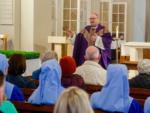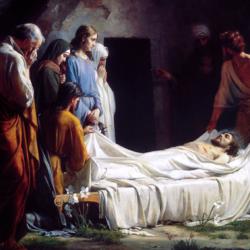Sisters of Notre Dame de Namur 175th anniversary: Growth in Lowell and into Tyngsborough
Sisters of Notre Dame de Namur in New England -- The early years
The Sisters of Notre Dame de Namur expand into the Merrimack Valley
Sisters of Notre Dame de Namur 175th anniversary: 'The Lake' land use changes but remains a haven for those in need
Sisters of Notre Dame de Namur 175th anniversary: Emmanuel College -- Mission made manifest
The mill cities in Massachusetts, which grew out of the Industrial Revolution, created fertile ground for the mission of the Sisters of Notre Dame de Namur (SNDdeN). Immigrant families flooded the cities along the Merrimack River, seeking work in the mills and a better life for their children. The textile mills established in Lowell drew workers from multiple ethnic groups, and the city's neighborhoods reflected these cultural and religious roots.
One area called "The Paddy Camps," later known as "The Acre," became home to many of the Irish, and in 1831, St. Patrick Church was built there to serve the spiritual needs of the Irish Catholic community. In September 1852, in response to a request from Father Timothy O'Brien, Notre Dame de Namur Sisters Desiree, Marie Honorine, Frances, Rose, and Stanislaus arrived in Lowell from Cincinnati to open a school. The opening day of school was Sept. 23, 1852. The sisters entered the neighborhood, ringing a bell to call their students, even though the school building was not built. On the first day, they had 150 students; within three days, they had 300. The sisters taught most classes in the wooden house provided for them, utilizing every nook and cranny! In faithfulness to St. Julie Billiart's vision to educate young girls, the sisters' school was only for girls.
These beginning days were challenging for the sisters. Their attentiveness to the needs of the children, their families, and their neighbors soon transitioned into action, broadening their ministry at St. Patrick's and The Acre. Sister Desiree was very concerned for the many children left alone for long periods while their parents worked 12- to 14-hour days in the mills. Older students often missed school to stay home to care for their siblings. Sister Desiree immediately created what we would today call "daycare," perhaps one of the first childcare centers in the country, to watch the younger children and provide them with activities, safety, and love. As winter drew near, she realized that many students lived at distances that would make walking to school difficult, if not impossible. Arrangements were made for those students and some of the younger children to live at the convent during the school week. Their parents gave permission and provided bedding and necessities, and the sisters set aside a room for these students.
Over time, this led to the establishment of a boarding school (academy), which was open to poor children for a small monthly payment, but families of more means, who saw the boarding school as a privilege, soon requested access. The parish school and the academy grew as word spread about the academic excellence, religious instruction, and life skills these schools provided. The plot of land at 311 Adams Street soon housed the boys' school, taught by the Xaverian Brothers, the girls' school, and the academy. In 1865, the academy was incorporated as St. Patrick Academy. On April 1, 1871, they laid the foundation stone for a new academy building.
Sister Desiree initiated groups of women from the parish who would meet evenings and Sundays. These groups, or sodalities, were spiritual in nature but also included outreach to people experiencing poverty. They visited the sick, fed the hungry, cared for those in need and rented a house where they could take the ill. This ministry later grew into St. John Hospital. Sister Desiree's charity, vision, deliberation, and creativity in addressing the needs of so many throughout Lowell led to her being known as Mother Desiree. Before she died in 1879, she laid a solid foundation for the work of the Sisters of Notre Dame de Namur in Lowell. She implemented ways to ease the lives of people experiencing poverty and supervised the construction and completion of four new buildings for the boarders and the parish school.
As the sisters' work continued, it began to take a toll on their health. Their physician urged their superior to find a place outside the city, where the sisters could rest and recuperate during summer. In 1907, the Brinley Estate in Tyngsborough was on the market. The sisters, amazed by the "beauty of the place and the surroundings," requested permission to purchase the property. They received permission and purchased the estate two years later. The SNDdeN, as well as other religious sisters in the Lowell area, enjoyed the property. This new property gave rise to new visions for the future, and the sisters had other plans. "Begin to build, and success will follow," was advice from the pastor of St. Patrick. "This is the right place for an academy, and you will have boarders from near and far." It took 20 years before the construction of the new academy was completed in 1927. St. Patrick Academy boarding school lasted until the academy moved to Tyngsborough and became known as the Academy of Notre Dame. St. Patrick School and St. Patrick Girls High School remained in Lowell. The first boarders slept in the dormitories on Nov. 22, 1927, and classes began on Nov. 28, 1927.
In 2003, the administration of St. Patrick School transferred from the parish to the Sisters of Notre Dame de Namur. The Academy of Notre Dame, Tyngsborough, experienced changes as well. In 1984, the elementary school accepted boys for the first time, and in 2020, the high school became co-ed. St. Patrick School and the Academy of Notre Dame continue today as sponsored ministries of the Sisters of Notre Dame de Namur. The schools remain true to their roots and live out the mission of St. Julie Billiart. Each school is enriched by its cultural, ethnic, economic, and religious diversity. Thanks to generous scholarships and financial assistance, many St. Patrick graduates are continuing their education at NDA. In 1852, Mother Desiree and her little band of sisters made sandwiches for those who came to their door who were homeless and suffering. Today, the high school students at NDA make sandwiches to help a local parish feed people experiencing homelessness living along the Merrimack River. St. Patrick School continues to welcome and provide for newly arrived immigrant children and families. At this 175th Jubilee time, the sisters, alumni, benefactors, students, and families continue proclaiming, "Ah, qu'il est bon, le bon Dieu!" ("How Good God Is!")
SISTER JOANNE SULLIVAN, SNDDEN, IS A STAFF MEMBER AT NOTRE DAME ACADEMY, TYNGSBOROUGH. SHE PREVIOUSLY SERVED AS PRINCIPAL OF ST. PATRICK SCHOOL, LOWELL, FOR 24 YEARS.



















